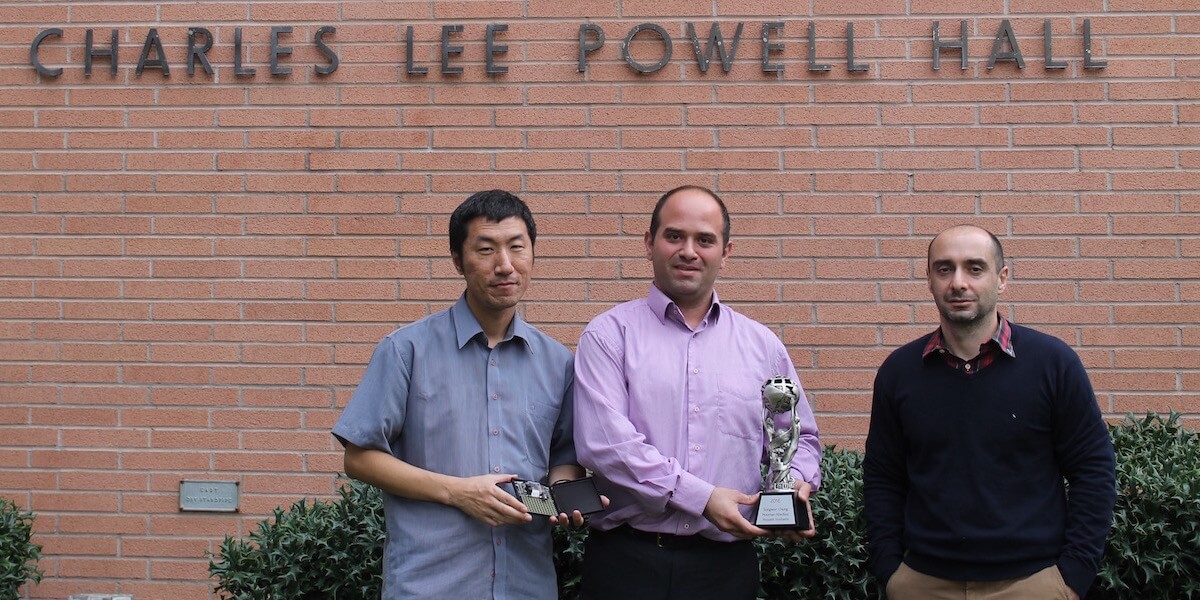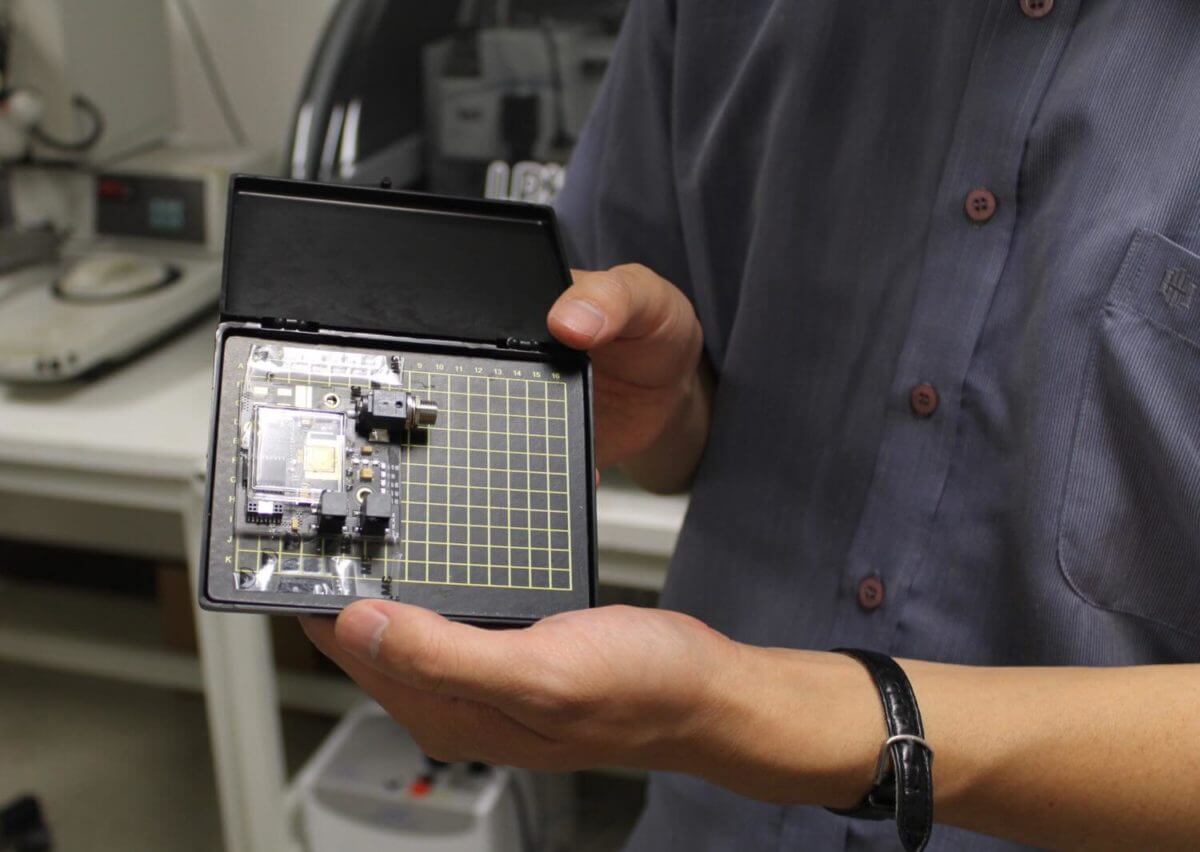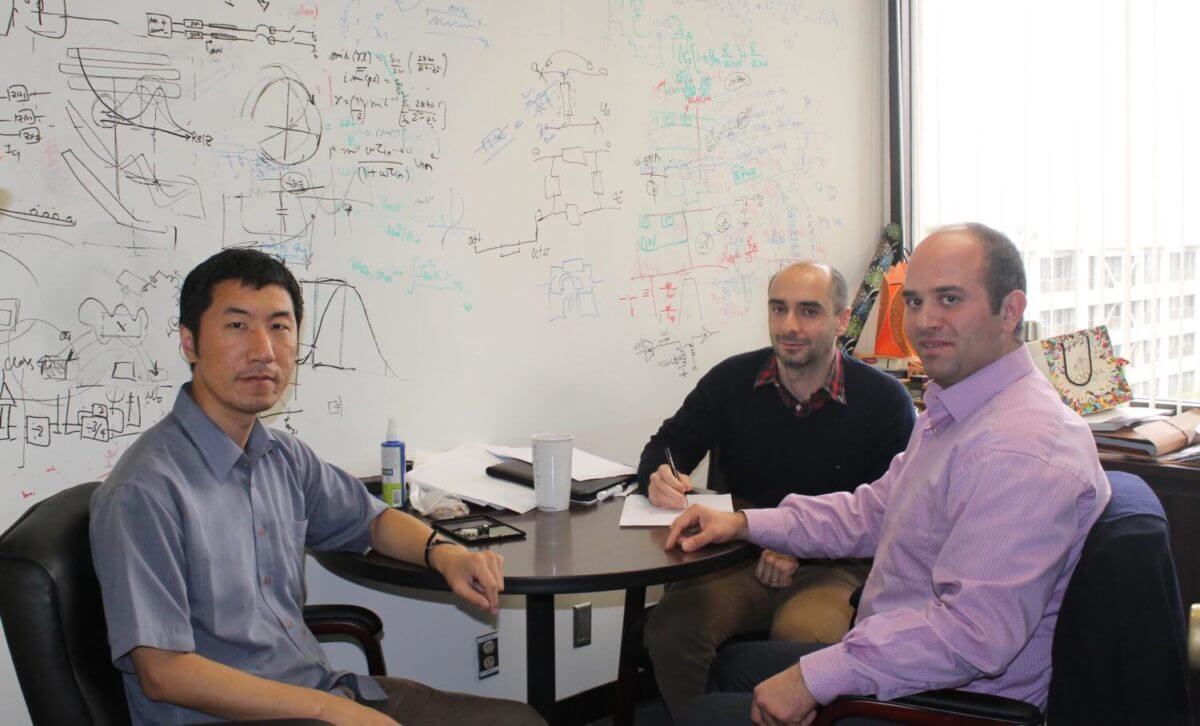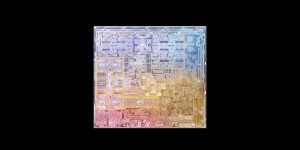
From Left: SungWon Chung, Hooman Abediasl, and Hossein Hashemi with their 1st place prize and chip.
Nokia’s Bell Labs Prize is awarded each year to people whose research presents “game changing ideas” in STEM fields. Now in its third year, the competition attracted over 250 proposals from 41 countries. To be considered for the $100,000 prize, the technology presented should have the potential to be better than current state-of-the-art technology by a factor of 10.
This year’s first prize was awarded to the team of Professor Hossein Hashemi, Research Associate Dr. SungWon Chung, and Ph.D. candidate Hooman Abediasl, all from the Ming Hsieh Department of Electrical Engineering at USC Viterbi.
The trio designed a new architecture that lets us tightly pack lots of optical nano-antennas, tunable optical components, and associated electronic control circuitry onto a single chip. In fact, they were able to get ten times more nano-antennas on a chip than anyone before. This advancement has profound implications for self-driving cars and drones, 3-D projection technology, and high-speed optical communications.
“The winners embody the essence of Bell Labs and the Bell Labs Prize – solving the great challenges facing humankind in the coming 10 years, with disruptive solutions that think differently,” said President of Nokia Bell Labs and Nokia’s Chief Technology Officer, Marcus Weldon.
Today, electrical engineering touches nearly every aspect of people’s lives. From medical imaging, to speech and language recognition, to green energy, the internet of things, and quantum computing. But it’s one of the more established areas, chip design, that remains a cornerstone of the discipline. So many of the amazing things being done by engineers today simply wouldn’t be possible without the equally amazing advancements in chip technology.

This groundbreaking new chip has 1,024 optical nano-antennas inside. Over ten times more than any other previous design had achieved.
To better appreciate the impact of their work, think of those self-driving cars we’ve all seen being tested on the road. Have you noticed the large and heavy piece of machinery on top? Inside is a laser attached to several moving mirrors. As the mirrors move around the laser, the beam is shot in many directions, allowing it to scan for other cars, pedestrians, or cliffs. Not only is this equipment bulky and unattractive, it also happens to cost as much as many of the cars on the road. And if you think attractiveness isn’t an important value for new technology, just ask all those blackberry users out there how they like their keyboards.
The USC team’s research replaces this current model with a compact, non-moving system at a fraction of the cost. So how did they do it? First, a bit of background into the world of electromagnetic signals.
Electromagnetic signals are used to transfer information (think of wireless communications) or to sense objects in the environment (think of a radar) or even capture an entire scene (think of a camera). Sometimes, electromagnetic signals are omni-directional, that is, they propagate in all directions. That’s good for things like television or radio broadcasts.
Sometimes the signal needs to be more directional, or focused. A dish antenna that is adjusted to receive broadcast signals from satellites forms a highly directional electromagnetic beam.
The problem with directional signals is that the beam must be constantly re-aligned as we move around. Mechanically rotating antennas are large, expensive, and not always attractive; they might look pretty sweet on the back of a naval ship, but not so much on a cell phone.
In 1909, Nobel Laureate Karl Ferdinand Braun found a solution to form directional electromagnetic beams and steer them without mechanically moving parts in what we now refer to as “phased arrays.” Phased arrays use an array of antennas that are fed with different phases of the same signal.
Then, in the midst of WWII, the first Phased Array Radar was developed and installed in the B-29 Superfortress bombers. Today the technology has come even further. It’s now used in cars for blind-spot detection and park assist, and is being applied to upcoming 5G wireless standards in cell phones. So, the technology exists, but is it living up to it’s potential?
Hashemi was already a world leader in phased arrays before this latest win. For his dissertation in 2003, he demonstrated the world’s first single-chip radio, frequency, phased array. Then, just four years later, Hashemi and some former students presented another phased array integrated circuit that was 10 times smaller than the one he developed in 2003. “Right around that time, I started to think about how cool it would be to realize a phased array at optical frequencies.” Hashemi said.
Optical signals, like radio signals, are also electromagnetic. But they can also be much more directional – think of a laser pointer and the degree of control you have over where the beam is placed.
First the good news: the frequency of optical signals is a hundred thousand times higher than the frequency of signals used in smartphones and ten thousand times higher than the frequency of car radars. That’s a lot of potential for better performance.
Now the hard part: This means the size of an optical phased array must be ten thousand to a hundred thousand times smaller than radio frequency phased arrays. To get all the components onto a chip they need to get smaller. Like, a lot smaller. Like, nano-scale small.
In winning the prize, the USC team found a way for that phased array to get thousands of times smaller.
In optical phased arrays, nano-antennas must be spaced only a couple of micrometers away from each other. A micrometer is one millionth of a meter in width. Prior to this breakthrough, the record was held by Intel, which was able to put 100 antennas on a chip, with another 100 controllers and 100 phase shifters – 300 components in all and still not enough to get the job done.
Using their new architecture, the USC researchers put 1,024 optical nano-antennas as well as all the necessary variable phase shifters and control electronics on a single chip.
Earlier in his career, Hashemi’s expertise was in electronics, not optics. It took several years just to learn everything to take on this project. When Hooman joined as a Ph.D. student in 2010, Hashemi told him about his vision for an optical phased array.
“Hooman, who was also new to this field, was brave, or maybe naïve, enough to agree to work on this with me.” Hashemi says. The two finally achieved their first optical phased array in 2014, and that same year they were joined by SungWon, who had just received a Ph.D. from MIT.
Hooman’s outlook reflects why the team had so much success. “The fact that our skills complemented each other really well was helpful. Professor Hashemi brought the initial vision and managed the project. I developed the core technology from scratch, and SungWon brought it to the next generation.”
 Suddenly, a whole new world of possibilities has been realized. We now have chips that can put out very narrow optical beams, at a very wide steering angle, without the need for expensive moving parts or oversized pieces of material.
Suddenly, a whole new world of possibilities has been realized. We now have chips that can put out very narrow optical beams, at a very wide steering angle, without the need for expensive moving parts or oversized pieces of material.
That means that drones and self-driving cars can operate at unprecedented speeds and efficiency – bringing us one step closer to humanity’s ultimate goal of flying drone pizza delivery.
It also means that even more futuristic technologies just got a lot closer to becoming a reality. Imagine a kind of 3-D facetime through your mobile phone, where instead of speaking with a boring old screen, you’re talking to a three-dimensional projection of your friend. Remember that scene in Return of the Jedi where the rebels bring up the 3-D specs of the Death Star and show everyone where the weak point is? Yeah, like that.
So yes, electrical engineering encompasses many other areas aside from chip design. But it’s easy to forget how much of our technology is reliant on advancements like this one. The engineers building these systems (literally constructing them at the nano-level piece by piece!) provide the foundation for fields like medical imaging, internet of things, satellite communication, and so much more. And while the newer additions to the electrical engineering family are equally fascinating, sometimes you gotta give respect to your roots.
Published on January 17th, 2017
Last updated on November 8th, 2017











